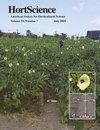Physio-biochemical Behavior and Health Effects of Pepper Plants Subjected to Lead Stress and Their Responses to Remediating Agents as Microbial Activity and Phosphorus
IF 1.5
3区 农林科学
Q2 HORTICULTURE
引用次数: 0
Abstract
This work assessed the alleviating effects of bacteria (Bacillus subtilis) and phosphorus as environmentally friendly materials on the cultivation of pepper plants in polluted soil with lead (Pb) in forms of PbSO4, and Pb(NO3)2 at rates of 0, 1000, 2000 and 3000 µg Pb/g soil. Pot experiments were conducted to study the growth parameters, some physiological factors, biochemical constituents, and yield attributes, as well as the tolerance index (TI), translocation factor (TF), bioconcentration factor (BCF), and health effects [daily intake of heavy metals (DIM), health risk index (HRI), and carcinogenic risk (CR)]. Increasing the Pb concentration of all Pb salt used in soil severely affected the plant vegetative growth parameters. In comparison with other Pb salt forms, Pb(NO3)2 salt had a strong inhibitory impact. Additionally, the photosynthetic pigments in leaves were negatively impacted by all Pb salt forms. The application of Pb in all salt forms led to changes in the leaf water deficit (LWD), osmotic pressure, and membrane integrity and decreased the total water content, relative water content (RWC), transpiration rate, and leaf succulence. Pollution with Pb salts considerably decreased the yield constituents and various chemical properties of pepper, more so in the presence of Pb nitrate than in the presence of Pb sulfate type. A comparison of the concentration of Pb presence of Pb nitrate was greatly increased than the Pb sulfate in the whole plants. The safe limit of 0.3 mg/kg was exceeded by the Pb concentration in pepper fruits (6.3 and 4.3 mg/kg) cultivated in Pb-contaminated soil [with Pb(NO3)2 and PbSO4, respectively]. Additionally, Pb sulfate had a greater detrimental effect on Pb uptake in several plant organs than other Pb salt forms. The TI of pepper plants treated with salt types was >60% with PbSO4 (75.6%), whereas it was <60% with Pb(NO3)2 (35.2%). The BCF values of pepper plants in the polluted Pb soils varied from 0.10 to 0.41, indicating a moderate accumulator plant. At every level of Pb contamination with all Pb salt types, the sequence of Pb TF values was as follows: roots (TFr) > shoots (TFsh) > fruits (TFf), with TF values < 1. When compared with TFr and TFsh, TFs for shoot to fruits (TFf) had the lowest values (range, 0.07–0.22). The DIM, HRI, and CR values of pepper plants revealed that the Pb of fruit of stressed pepper plants is within safe limits. In addition to reducing the detrimental effects of intolerable Pb levels (2000 and 3000 µg Pb/g soil) on the majority of the aforementioned characters, adding Bacillus bacteria as a bio-agent and phosphorus as a chemo-agent to Pb-polluted soils also stimulated growth, increased yield, controlled plant water relations, protected photosynthetic pigments, and sharply decreased the Pb accumulation in plant organs. The Bacillus bacteria application resulted in some superior characteristics, such as root length, leaf number, leaf length, leaf area, leaf area index, fresh biomass, dry biomass, photosynthetic pigments, quantity yield attributes, reduction Pb accumulation in all plant organs, TI, TFr, TFf, BCF, in health effects trials, whereas phosphorus application improved plant height, leaf width, RWC, LWD, osmotic pressure, total soluble solids, acidity, total carbohydrates, total protein, and TFsh.受到铅胁迫的辣椒植物的生理生化行为和健康影响及其对微生物活性和磷等补救剂的反应
本研究评估了细菌(枯草芽孢杆菌)和磷作为环境友好材料对辣椒植物在铅污染土壤中的栽培效果,铅污染土壤的形式为 PbSO4 和 Pb(NO3)2,浓度分别为 0、1000、2000 和 3000 µg Pb/g。盆栽实验研究了铅的生长参数、某些生理因素、生化成分、产量属性以及耐受指数(TI)、易位因子(TF)、生物富集因子(BCF)和健康影响[重金属日摄入量(DIM)、健康风险指数(HRI)和致癌风险(CR)]。土壤中使用的所有铅盐的铅浓度增加都会严重影响植物的植被生长参数。与其他形式的铅盐相比,Pb(NO3)2 盐具有很强的抑制作用。此外,叶片中的光合色素也受到所有铅盐形式的负面影响。施用所有形式的铅盐都会导致叶片水分亏缺(LWD)、渗透压和膜完整性发生变化,并降低总含水量、相对含水量(RWC)、蒸腾速率和叶片肉质度。铅盐污染大大降低了辣椒的产量成分和各种化学性质,硝酸铅比硫酸铅更明显。通过比较全株植物中的铅浓度,发现硝酸铅比硫酸铅的浓度高得多。在受铅污染的土壤(分别含有 Pb(NO3)2 和 PbSO4)中栽培的辣椒果实中的铅浓度(分别为 6.3 和 4.3 毫克/千克)超过了 0.3 毫克/千克的安全限值。此外,与其他形式的铅盐相比,硫酸铅对多个植物器官的铅吸收具有更大的不利影响。使用硫酸铅(75.6%)处理辣椒植株的 TI>60%,而使用硫酸铅处理的植株的 TI(TFsh)>果实(TFf),TF 值小于 1。与 TFr 和 TFsh 相比,芽到果实(TFf)的 TF 值最低(范围为 0.07-0.22)。辣椒植株的 DIM、HRI 和 CR 值表明,受胁迫辣椒植株果实的铅含量在安全范围内。在受铅污染的土壤中添加枯草芽孢杆菌作为生物制剂和磷作为化学试剂,除了能降低难以忍受的铅含量(2000 和 3000 µg Pb/g 土壤)对上述大多数特征的不利影响外,还能刺激生长、增加产量、控制植物水分关系、保护光合色素,并显著减少植物器官中的铅积累。在健康影响试验中,施用芽孢杆菌可获得一些优异特性,如根长、叶片数、叶长、叶面积、叶面积指数、鲜生物量、干生物量、光合色素、产量属性、减少所有植物器官中的铅积累、TI、TFr、TFf、BCF,而施用磷可改善株高、叶宽、RWC、LWD、渗透压、总可溶性固形物、酸度、总碳水化合物、总蛋白和 TFsh。
本文章由计算机程序翻译,如有差异,请以英文原文为准。
求助全文
约1分钟内获得全文
求助全文
来源期刊

Hortscience
农林科学-园艺
CiteScore
3.00
自引率
10.50%
发文量
224
审稿时长
3 months
期刊介绍:
HortScience publishes horticultural information of interest to a broad array of horticulturists. Its goals are to apprise horticultural scientists and others interested in horticulture of scientific and industry developments and of significant research, education, or extension findings or methods.
 求助内容:
求助内容: 应助结果提醒方式:
应助结果提醒方式:


